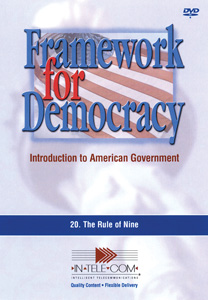THE RULE OF NINE
DVD
Unlike members of the legislative and executive branches, members of the judicial branch are appointed by the president for life and confirmed by the Senate. The U.S. Supreme Court was the only court specifically mentioned in the U.S. Constitution. Other lower courts have been established through additional legislation. Today, the lowest rung of federal trial courts (of which there are over 90) are called U.S. District Courts. The 12 numbered and one special court above them are known as the U.S. Circuit Courts. Since the nine-member Supreme Court hears relatively few cases, and it exercises a great deal of discretion over its docket, most decisions are resolved in the lower courts. Each state has its own system of courts. In contrast to the federal judiciary, some state judges are elected, and many have fixed terms in office. Cases may sometimes be appealed from the state to federal courts.
Learning objectives:
- Recognize that American courts are both legal and political bodies.
- Understand the key difference between members of the judicial branch and members of the executive and legislative branches.
- Describe the composition, jurisdiction, and selection of Supreme Court justices and discuss how they decide which cases to accept.
- Describe the three layers of the federal judicial system and explain how U.S. District Courts and U.S. Circuit Courts differ from the U.S. Supreme Court.
- Understand key similarities and differences between the U.S. federal courts and the U.S. state courts.
- Discuss the key players in the appointment and confirmation processes for U.S. federal courts (including the U.S. Supreme Court) and describe the make-up of a typical federal judge.
This title is part of the series: FRAMEWORK FOR DEMOCRACY
| Publisher | INTELECOM |
|---|---|
| Grade | 10 and up |
| Color | Color and black-and-white |
| Run Time | 26 minutes |

